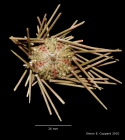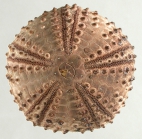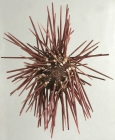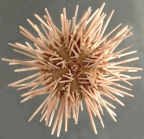
| Intro | | About | | Wiki | | Search traits | | Data explorer | | Literature | | Definitions | | Sources | | Webservices | | Statistics | | Feedback | | Editors | | Log in |
WoRMS taxon detailsArbacia stellata (Blainville, 1825; ?Gmelin, 1791)
Arbacia incisa (A. Agassiz, 1863) · unaccepted (subjective junior synonym)
Echinocidaris (Agarites) stellatus (Blainville, 1825; ?Gmelin, 1791) · unaccepted (transferred to Arbacia)
Echinocidaris incisa A. Agassiz, 1863 · unaccepted (subjective junior synonym)
Echinocidaris longispina Lütken, 1864 · unaccepted (subjective junior synonym)
Echinocidaris stellatus (Blainville, 1825; ?Gmelin, 1791) · unaccepted (transferred to Arbacia)
Echinus stellatus Gmelin, 1791 · unaccepted (transferred to Arbacia)
marine,
recent only
Not documented
Kroh, A.; Mooi, R. (2025). World Echinoidea Database. Arbacia stellata (Blainville, 1825; ?Gmelin, 1791). Accessed through: World Register of Marine Species at: https://www.marinespecies.org/aphia.php?p=taxdetails&id=513125 on 2025-05-25
Date action by
Nomenclatureoriginal description
(of Echinocidaris incisa A. Agassiz, 1863) Agassiz, A. (1863). List of the echinoderms sent to different institutions in exchange for other specimens, with annotations. <em>Bulletin of the Museum of Comparative Zoölogy at Harvard College.</em> 1: 17-28. page(s): 20 [details] original description (of Echinocidaris longispina Lütken, 1864) Lütken, C. F. 1864. Bidrag til Kundskab om Echiniderne. Videnskabelige Meddelelser fra den naturhistoriske Forening i Kjöbenhavn 1863, 69-207., available online at https://www.biodiversitylibrary.org/page/35851679 page(s): 130-131; pl. 1: fig. 7 [details] original description (of Echinus stellatus Gmelin, 1791) Gmelin, J. F. (1791). Vermes. In: Gmelin J.F. (Ed.) Caroli a Linnaei Systema Naturae per Regna Tria Naturae, Ed. 13. Tome 1(6). G.E. Beer, Lipsiae [Leipzig]. pp. 3021-3910. <em>Systema Naturae. Linneaeus (ed.). Ed. 13.</em> 1: pars. 6., available online at http://www.biodiversitylibrary.org/item/83098#5 page(s): 3174 [details] basis of record Mortensen, T. (1935). A Monograph of the Echinoidea. II. Bothriocidaroida, Melonechinoida, Lepidocentroida, and Stirodonta, 647 pp., C. A. Reitzel & Oxford University Press, Copenhagen & London. page(s): 575-577 [details] Othercontext source (PeRMS)
Solís-Marín, F. A.; Alvarado, J. J.; Abreu-Pérez, M.; Aguilera, O.; Alió, J.; Bacallado-Aránega, J. J.; Barraza, E.; Benavides-Serrato, M.; Benítez-Villalobos, F.; Betancourt-Fernández, L.; Borges, M.; Brandt, M.; Brogger, M. I.; Borrero-Pérez, G. H.; Buitrón-Sánchez, E.; Campos, L. S.; Cantera, J.; Clemente, S.; Cohen-Renjifo, M.; Coppard, S.; Costa-Lotufo, L. V.; del Valle-García, R.; Díaz, Y.; Díaz de Vivar, M. E.; Díaz-Martínez, J. P.; Durán-González, A.; Epherra, L.; Escolar, M.; Francisco, V.; Freire, C. A.; García-Arrarás, E.; Gil, D. G.; Guarderas, P.; Hadel, V. F.; Hearn, A.; Hernández, J. C.; Hernández-Delgado, E. A.; Herrera-Moreno, A.; Herrero-Pérezrul, M. D.; Hooker, Y.; Honey-Escandón, M. B. I.; Lodeiros, C.; Luzuriaga, M.; Manso, C. L. C.; Martín, A.; Martinez, M. I.; Martínez, S.; Moro-Abad; Mutschke, E.; Navarro, J. C.; Neira, R.; Noriega, N.; Palleiro-Nayar, J. S.; Pérez, A. F.; Pérez-Ruzafa, A.; Prieto-Rios, E.; Reyes, J.; Rodríguez, R.; Rubilar, T.; Sancho-Mejía, T.; Sangil, C.; Silva, J. R. M. C.; Sonnenholzner, J. I.; Ventura, C. R.; Tablado, A.; Tavares, Y.; Tiago, C. G.; Tuya, F.;Williams, S. M. (2013). Appendix. <em>In: J. J. Alvarado & F. A. Solís-Marín (eds), Echinoderm Research and Diversity in Latin America.</em> pp. 471-510. Springer; Berlin & Heidelberg. page(s): 543-654. [details]
additional source Lessios, H. A., Lockhart, S., Collin, R., Sotil, G., Sanchez-Jerez, P., Zigler, K. S., Perez, A. F., Garrido, M. J., Geyer, L. B., Bernardi, G., Vaquier, V. D., Haroun, R. & Kessing, B. D. 2012. Phylogeography and bindin evolution in Arbacia, a sea urchin genus with an unusual distribution. Molecular Ecology 21, 130-144., available online at https://doi.org/10.1111/j.1365-294x.2011.05303.x [details]  Present Present  Present in aphia/obis/gbif/idigbio Present in aphia/obis/gbif/idigbio  Inaccurate Inaccurate  Introduced: alien Introduced: alien  Containing type locality Containing type locality
Syntype (of Echinocidaris incisa A. Agassiz, 1863) MCZ 467, geounit Panamanian Exclusive Economic Zone [details]
Syntype (of Echinocidaris incisa A. Agassiz, 1863) MCZ 475, geounit Mexican Exclusive Economic Zone [details]
Syntype (of Echinocidaris incisa A. Agassiz, 1863) MCZ 523, geounit Mexican Exclusive Economic Zone [details]
From editor or global species database
Authority It is a very deplorable fact that there is no certainty that Gmelin's Echinus stellatus is the same as the present species. The diagnosis given by Gmelin (Op. cit. [1788: p. 3174]) "Echinus spinis infimis capillaribus. Habitat in mari americano", of course, does not say anything; but he refers to Tab. XIII. 7 of Seba's "Thesaurus locupl." Ill. "Echinometra purpurea americana". Nobody could tell which species this figure really represents, but, anyhow, it has naked spaces in the interambulacra so that it is quite possible that it really is the present species, and it is by no means certain, as says Clark (Op. cit. 1913 [p. 220]) that Gmelin's and Blainville's Ech. stellatus are not identical. Blainville did not mean to identify his Ech. stellatus with Gmelin's species of the same name, but to establish it as a new species, saying expressly "j'ai etabli cette espece" (Op. cit. [1825] p. 76). Must we then necessarily follow Clark in rejecting the commonly used, excellent name stellata, for the much less appropriate name incisa of A. Agassiz? (That the species incisa is no more recognizable from the original diagnosis than is GmeIin's species stellatus, is of no importance, of course, since we know for certain that Agassiz meant the present species). I do not think it necessary; we may designate the species stellata (Blainville; ? Gmelin) and thus keep the excellent, all known name. In any case I think it objectionable simply to use the name incisa, without giving at the same time the name stellata as a synonym, so that anybody, also when not very familiar with the subject, may be able to see which species is meant with the name. [details]
To Barcode of Life (19 barcodes)
To Biodiversity Heritage Library (16 publications) (from synonym Arbacia incisa (A. Agassiz, 1863)) To Biodiversity Heritage Library (34 publications) To European Nucleotide Archive, ENA (Arbacia incisa) (from synonym Arbacia incisa (A. Agassiz, 1863)) To European Nucleotide Archive, ENA (Arbacia stellata) To GenBank (17 nucleotides; 17 proteins) (from synonym Arbacia incisa (A. Agassiz, 1863)) To GenBank (27 nucleotides; 27 proteins) To USNM Invertebrate Zoology Echinodermata Collection (72 records) (from synonym Arbacia incisa (A. Agassiz, 1863)) To ITIS |






